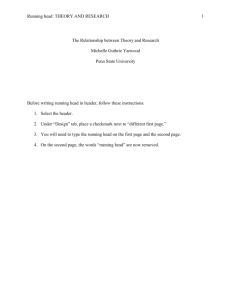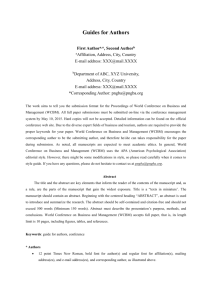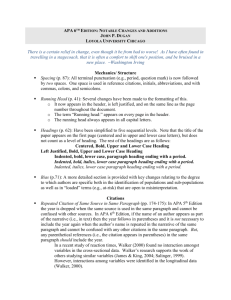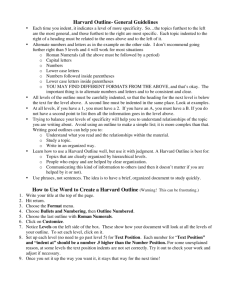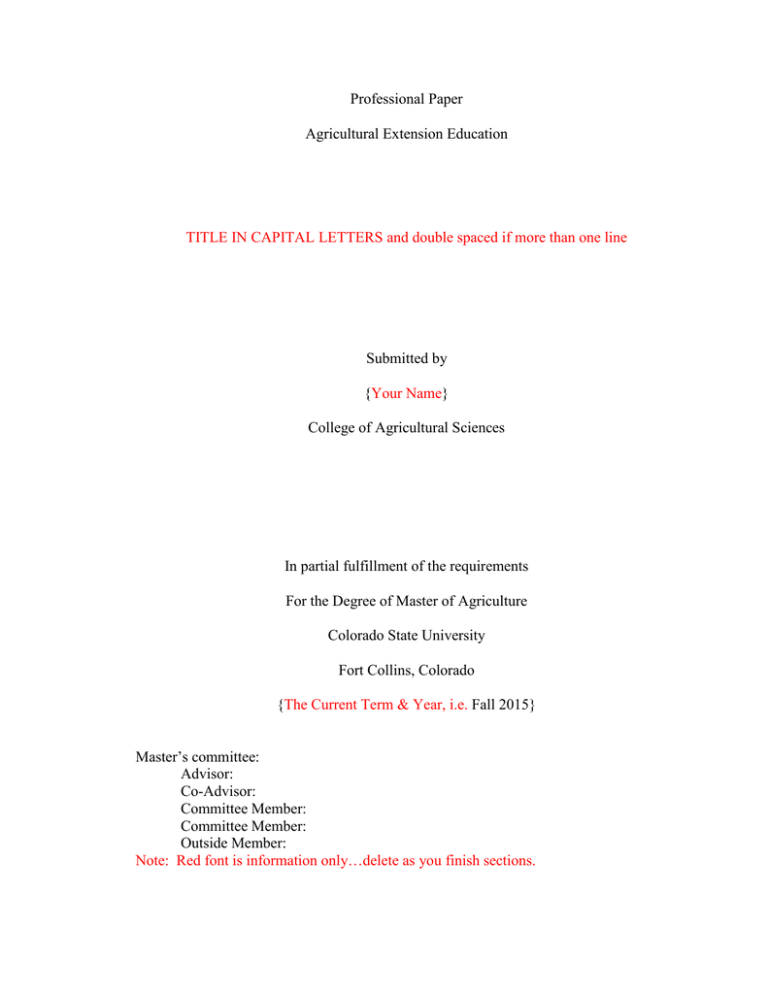
Professional Paper
Agricultural Extension Education
TITLE IN CAPITAL LETTERS and double spaced if more than one line
Submitted by
{Your Name}
College of Agricultural Sciences
In partial fulfillment of the requirements
For the Degree of Master of Agriculture
Colorado State University
Fort Collins, Colorado
{The Current Term & Year, i.e. Fall 2015}
Master’s committee:
Advisor:
Co-Advisor:
Committee Member:
Committee Member:
Outside Member:
Note: Red font is information only…delete as you finish sections.
ii
EXAMPLE OF COPYRIGHT PAGE
Center text vertically and horizontally
Copyright by John Arthur Brown 2015
All Rights Reserved
(required page)
This page is included immediately after the title page
This page is not assigned a number nor counted
iii
ABSTRACT
{APA Level 1: Centered, Boldface, Times New Roman, 12pt, Uppercase and
Lower case}
{Paragraph is indented} Start word processing after red font to retain format.
iv
For formatting tips, please see these sites:
http://lib.colostate.edu/cat/thesis-dissertation-formatting
http://lib.colostate.edu/images/cat/TOC_Styles_ETD-4.pdf
CONTENTS
ABSTRACT ....................................................................................................................... iii
CONTENTS………………………………………………………………………………iv
CHAPTER 1 - INTRODUCTION ...................................................................................... 1
Background (or Overview) (Level 1 Heading 1) .................................................... 1
Statement of the Research Problem (Level 1 Heading 2) ....................................... 1
Research Questions ..................................................................................... 1
Definition of Terms..................................................................................... 1
Significance of the Study ............................................................................ 1
Researcher’s Perspective ........................................................................................ 1
CHAPTER 2 - REVIEW OF THE LITERATURE ............................................................ 2
APA Level 1 Heading 2, etc. .................................................................................. 2
CHAPTER 3 – METHODOLOGY, RESULTS, DISCUSSION, AND CONCLUSIONS 3
Possible subtitles: .................................................................................................... 4
Methodology (Describe if you did any data analysis) ............................................ 4
Results or Findings ................................................................................................. 4
Discussion or Implications for Practice .................................................................. 4
Relevance to Other Disciplines ............................................................................... 4
Contribution to New Knowledge ............................................................................ 4
Limitations .............................................................................................................. 4
Conclusions ............................................................................................................. 4
Recommendations for Further Research or Recommendations for Practice .......... 4
References ........................................................................................................................... 5
CHAPTER 1 - INTRODUCTION
{APA Level 1: Centered, Boldface, Times New Roman, 12pt, Uppercase and
Lower case}
{Paragraph is indented}
{APA Level 2: Flush Left, Boldface, Times New Roman, 12 pt., Uppercase and
Lowercase}
{See p. 62 of the Sixth Edition of the Publication Manual of the American Psychological
Association for further heading levels’ formatting information.}
Background (or Overview) (Level 1 Heading 1)
{Paragraph is indented}
Statement of the Research Problem (Level 1 Heading 2)
{Paragraph is indented}
Research Questions
{Paragraph is indented}
Definition of Terms
{Paragraph is indented}
Significance of the Study
{Paragraph is indented}
Researcher’s Perspective
{Paragraph is indented}
2
CHAPTER 2 - REVIEW OF THE LITERATURE
Literature Research Strategy (APA Level 1 Heading2)
{Paragraph is indented}
APA Level 1 Heading 2, etc.
{Paragraph is indented}
{APA Level 2: Flush Left, Boldface, Times New Roman, 12 pt., Uppercase and
Lowercase}
{See p. 62 of the Sixth Edition of the Publication Manual of the American Psychological
Association for further heading levels’ formatting information.}
{This chapter and the next chapter(s) will usually have several levels of headings}
Keep your opinions and ideas out of this chapter. You are reporting what
other authors have said/found.
3
CHAPTER 3 – METHODOLOGY, RESULTS, DISCUSSION, AND
CONCLUSIONS
{APA Level 1: Centered, Boldface, Times New Roman, 12pt, Uppercase and
Lower case}
{Paragraph is indented}
{APA Level 2: Flush Left, Boldface, Times New Roman, 12 pt., Uppercase and
Lowercase}
{See p. 62 of the Sixth Edition of the Publication Manual of the American Psychological
Association for further heading levels’ formatting information.}
4
Possible subtitles:
Methodology (Describe if you did any data analysis)
Results or Findings
Discussion or Implications for Practice
Relevance to Other Disciplines
Contribution to New Knowledge
Limitations
Conclusions
Recommendations for Further Research or Recommendations for Practice
5
References
{Use APA Style 6th edition, however, to save space, citations may be single spaced
within as below. Or you may double space throughout.}
Anderson, B. (1992). Task and reflection in learning to learn. In J. Mulligan & C. Griffin
(Eds.), Empowerment through experiential learning: Explorations of good
practice (pp. 239-246). London: Kogan Page.
Bandura, A. (1986). Social foundations of thought and action: A social cognitive theory.
Englewood Cliffs, NJ: Prentice-Hall.
Belenky, M. F., Clinchy, B. M., Goldberger, N. R., & Tarule, J. M. (1986). Women's
ways of knowing: The development of self, voice and mind. New York: Basic
Books.
Blanco, F., & Rosa, A. (1997). Dilthey's Dream. Teaching history to understand the
future. International Journal of Educational Research, 27(3),189-200.
6
Appendix (if only one item) or Appendices (if several)
7
Appendix A: The Title of the Appendix
{If you have collected data involving humans, place IRB documents here}
{If you have collect data involving animals, place your certificate of training here}
{Each Appendix begins on a new page, Appendix B, C, etc.
8
9
Appendix A: Literature Review Database
{Database Template: We have a recommendation that would be helpful throughout your matriculation at CSU. IF you have a
passion, try to work on this topic of passion throughout your coursework and experiences at the University. As you review articles,
keep a database of the articles reviewed, so that you have a resource for future work. In your paper, include the database of pertinent
articles and/or all that you reviewed for the purpose of your paper, depending on the kind of literature review done, i.e. systematic
review, directed search, meta-analysis, etc. Below is an example in Word table format. Excel is suggested, with the final product for
use in the paper cut and pasted into this Word template for the professional paper.}
Citation
Anderson, D. (2013). First Aid & CPR.
Retrieved November 1, 2013, from
http://extension.unh.edu/events/index.cfm?e=a
pp.event&event_id=28234
Arbon, Paul, Jo Hayes, and Richard
Woodman. “First Aid and Harm Minimization
for Victims of Road Trauma: A Population
Study.” Pre-hospital and Disaster Medicine
26, no. 4 (2011).
http://ww.ncbi.nlm.nih.gov.pubmed/22008363
Auf der Heide, Erik. “The importance of
evidence-based disaster planning.” Annals of
emergency medicine 47, no. 1 (2006): 34-49.
Summary
First Aid and CPR training available to members of the University of New Hampshire
Cooperative Extension (p. xx)
We suggest listing the page number(s) where information is found in case you need to
“go back” to the information later.
he aim of this project was to acquire knowledge about the prevalence of first aid
training; the incidence of being a bystander and of providing first aid; the range of first
aid skills being utilized; the motivation to intervene; and, the perceived impact of first
aid training.
Category
First Aid & CPR
Disaster planning is only as good as the assumptions on which it is based. However,
some of these assumptions are derived from a conventional wisdom that is at variance
with empirical field disaster research studies. Knowledge of disaster research findings
might help planners avoid common disaster management pitfalls, thereby improving
disaster response planning. To illustrate the point, this article examines several common
assumptions about disasters, compares them with research findings, and discusses the
implications for planning.
Evaluation
Motivators and
Barriers for taking
First Aid and CPR
Trainings
10



